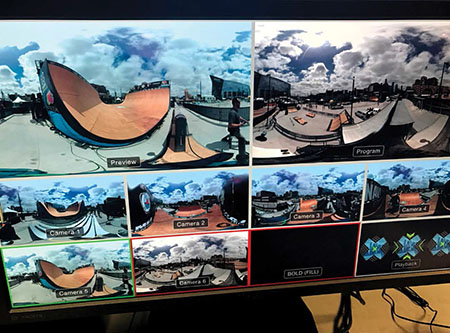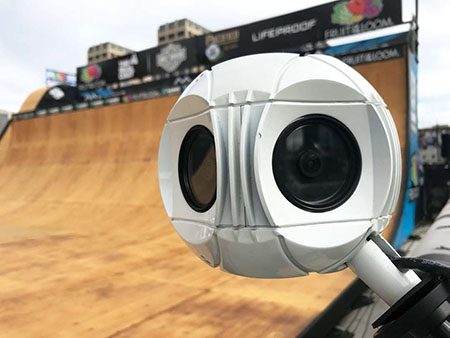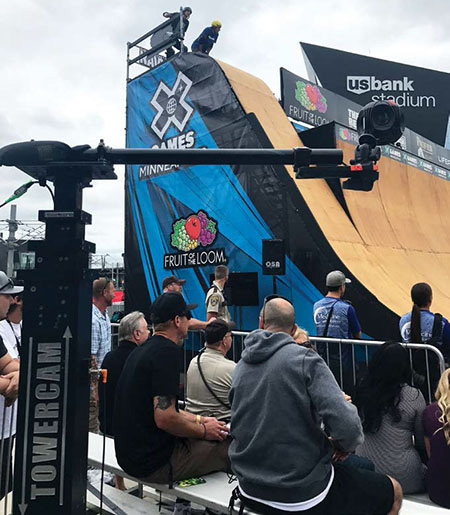ESPN Takes X Games Virtual
MINNEAPOLIS—Throughout its more than two decades in existence, ESPN’s X Games has proven to be a fertile ground for technological innovation and creativity. This summer’s games from Minneapolis, which were took place July 13–16 from the new U.S. Bank Stadium, proved no exception, marking the first time the network presented the telecast with an added option: a collaboration with Samsung Electronics and Los Angeles-based visual effects company Digital Domain that included immersive virtual reality streams of three X Games disciplines. Namely, the Skateboard Vert, BMX Street and Skateboard Street Amateurs were aired, live and exclusively, to 48 countries on Samsung Gear VR via the Samsung VR app.

X Games Minneapolis will go down as a notable event on the ESPN timeline for its inclusion of live VR. The screen pictured was inside the B-unit that was employed by Digital Domain.
This year’s X Games were also presented as a traditional TV production on ESPN, with support from Studio City, Calif.- based Echo Entertainment, with those two entities joined by Samsung and Digital Domain for the VR broadcast; Digital Domain handled VR production’s staffing and equipment, and used Echo’s B unit.
TRIO OF EVENTS
Digital Domain captured the VR content via six 360-degree cameras for the live production, according to Sam Reisner, staff software engineer with the ESPN Advanced Technology Group. “There has been very little live VR coverage,” he said, “and that live coverage is where the interest in this project lies.”
The three live VR events were exclusive to the Samsung VR headset that operates via the app, and were fully-produced shows “that included various fixed and roving cameras with specialty angles, such as a spider-view shot and telescoping tower at ground level,” said Reisner.

The six cameras used for the VR broadcast are a proprietary technology created by Digital Domain.
Graphics and replays were added within that 3D environment, “which gave us a fully-immersive, produced experience for the three live events,” he said, as well as replays on the app that were shot by ENG crews and edited in VR, then distributed on demand via the platform.
Get the TV Tech Newsletter
The professional video industry's #1 source for news, trends and product and tech information. Sign up below.
When Digital Domain captured the feeds from all six cameras—all of which were built in-house—“they were worked into a standard UHD 4K switcher, allowing their engineers to switch the cameras and cut and/or dissolve the angles, as well as key in graphics and position 2D graphics in the sphere,” Reisner said. “Then, the top bar across screen with timing, scoring and standings were created in house.”
Digital Domain then took all of the feeds and stitched them together, live, and switched them to a 4K HD signal that represented the whole 360-degree view that mapped out into a rectangle. “That made the producer able to present the video like any new HD video, in terms of transport, recording, streaming and switching,” Reisner said. “A few years ago, that was something that you couldn’t do live; but now they can, and it provided a key element of the broadcast.”
The B-unit housed an EVS switcher, Digital Domain’s 360 proprietary video processing system, as well as a Vizrt graphics system that was also used on the standard 2D broadcast.

A camera tower that was kept at about head height was employed by Digital Domain during the live VR broadcast.
FLEXIBILITY WAS KEY
Speaking of 2D, the Digital Domain VR system was also used to take in a 2D video feed and place it on a Jumbotron billboard.
“During the actual runs, we took the video from Echo’s production truck and showed it on the virtual Jumbotron, beside the action,” Reisner said. “Even though we had some amazing camera locations, we wanted to be sure that we showed alternate shots and replays within the Jumbotron.”
There was also an audio console taking a MADI feed from Echo from the traditional TV broadcast, with Digital Domain creating its own mix. And ESPN had the talent mic-ed, with additional audio feeds to mix in to the broadcast.
Distribution was handled by Digital Domain via a standard IP circuit at the stadium that transported the content to the Samsung Cloud in multiple bit rates (depending on available bandwidth), then distributed it through Samsung’s Live VR and its app.
Reisner said that ESPN has considerable expertise in distributing content that it gains via its streaming platforms, “and we leverage it in broadcasts like the X Games.”
He added that it was a “treat” to work in the new stadium. “One of the great things about the X Games is that we basically get to build the courses and layout them out how and where we want to,” he said. “It was fantastic to have such a flexible setup and it contributed to the success of the broadcasts.”
Mark R. Smith has covered the media industry for a variety of industry publications, with his articles for TV Technology often focusing on sports. He’s written numerous stories about all of the major U.S. sports leagues.
Based in the Baltimore-Washington area, the byline of Smith, who has also served as the long-time editor-in-chief for The Business Monthly, Columbia, Md., initially appeared in TV Technology and in another Futurenet publication, Mix, in the late ’90s. His work has also appeared in numerous other publications.

